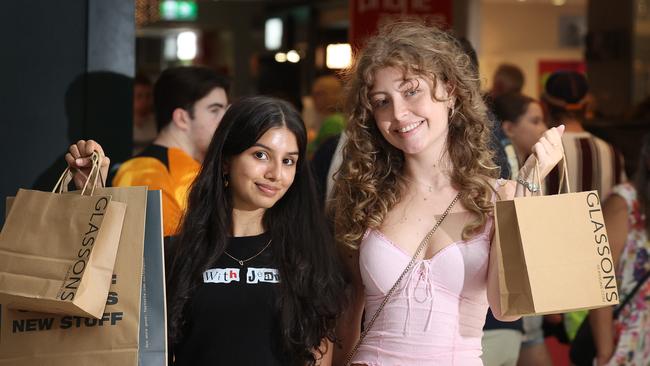Debt hangover looms after ‘YOLO’ spending binge
Reality is kicking in for many Australians after a record ‘you only live once’ retail splurge last year. Facing a debt hangover, the signs are that spending has already started to fall in January.
Business
Don't miss out on the headlines from Business. Followed categories will be added to My News.
After a string of sales events and end-of-year celebrations, Australians are in for a ‘debt hangover’ as consumers scale back spending into the new year.
Spending was 4 per cent down in the first week of January compared to the same period last year, ANZ’s latest spending report revealed.
The bank said it observed ‘weak’ spending during the end of 2022 and the start of this year, indicating the appetite for splurging had dwindled under interest rate hikes and inflation.
ANZ senior economist Adelaide Timbrell said non-food retailing or shopping in particular was week in the first week of January, down eight per cent on the same time a year ago.
“We expect consumption growth to slow in 2023, which will put downward pressure on
economic growth,” Ms Timbrell said.
She said, in particular, as mortgages gets more expensive, there will be a real slowdown in housing spending on a per person basis.
“2022 was the year that people absolutely spent up after two years of Covid and international border closures and 2023 is likely to be the year that people start to slow down and tighten their belts,” she said. “Because between inflation and high interest rates, the household budget is getting squeezed.”

Commonwealth Bank (CBA) economist Stephen Wu said analysis from credit and debit cards show spending did increase around Black Friday and Cyber Monday sales in November.
“We did see some science that consumers were shifting around their spending patterns to take advantage of these sales events,” he said.
That was reinforced by data released this week by the Australian Bureau of Statistics showing retail turnover in November rose 1.4 per cent to a record high $35.9bn, well ahead of the 0.6 per cent increase the market had expected. Year on year sales were up 7.7 per cent.
“This was the first Christmas period without any sort of restrictions and lockdowns,” Mr Wu said. “So we kind of do expect there was some sort of last hurrah of spending as people were able to celebrate that festive season with friends and family.
“But we think from this year, we should see a more material slowdown in consumer spending.”
The CBA has forecast a final 25 basis point interest rate hike to 3.35 per cent by the Reserve Bank in February, putting more pressure on households.
VanEck head of investments Russel Chesler expects spending to come off the boil in February.
“We believe Australians are enjoying life post-pandemic with a bit of a YOLO (you only live once) attitude, consumers are splashing out now, but might pull back in February after an over-indulgent holiday spending hangover kicks in,” he said.
RateCity said new figures from the RBA show total credit card debt has ticked up for the second month in a row, in a worrying sign some families may be resorting to the plastic to make ends meet. The total credit card bill attracting interest charges increased by $419m to $17.3bn in November, a 2.5 per cent increase on the previous month.
RateCity research director Sally Tindall said Australians spent a mammoth $75.7bn on their debit and credit cards in just one month.
“Many family budgets have been through the wringer over the last couple of months as the cost of just about everything continues to rise,” she said.
“Historically, credit card debt does typically pick up after the silly season is over. A lot of people put purchases on their credit card to help make ends meet or to perhaps buy something in the sale period, only to find that they can’t quite pay off the balance in full when their bill comes in.
“But it’s particularly concerning in 2023 because this is going to be a tough year financially for a lot of families.”

Ms Tindall said buy now pay later (BNPL) debts can also put pressure and cause stress when bills for rent, food and electricity come in.
But a recent survey by UBS revealed consumers are in a far stronger position than expected, drawing down on savings to fuel spending sprees. Consumers were bullish in the last three months of 2022 and still expected spending to remain strong over the next 12 months, according to UBS.
“These are surprisingly strong results, but we are not as surprised as probably the market would be by this because our last few consumer surveys have indicated the ongoing strength from the Aussie consumer,” said UBS equities strategist Richard Schellbach.
“Household savings will be used to support consumption, with 63 per cent of funding for travel still expected to be drawn from savings. Consumers continue to cite high levels of income stability and job security as the key positive supports behind their financial outlook.
But not all consumers are equal. Mr Schellbach said high-income earners were far more optimistic than those on lower salaries about their spending outlook.
More Coverage
Originally published as Debt hangover looms after ‘YOLO’ spending binge





